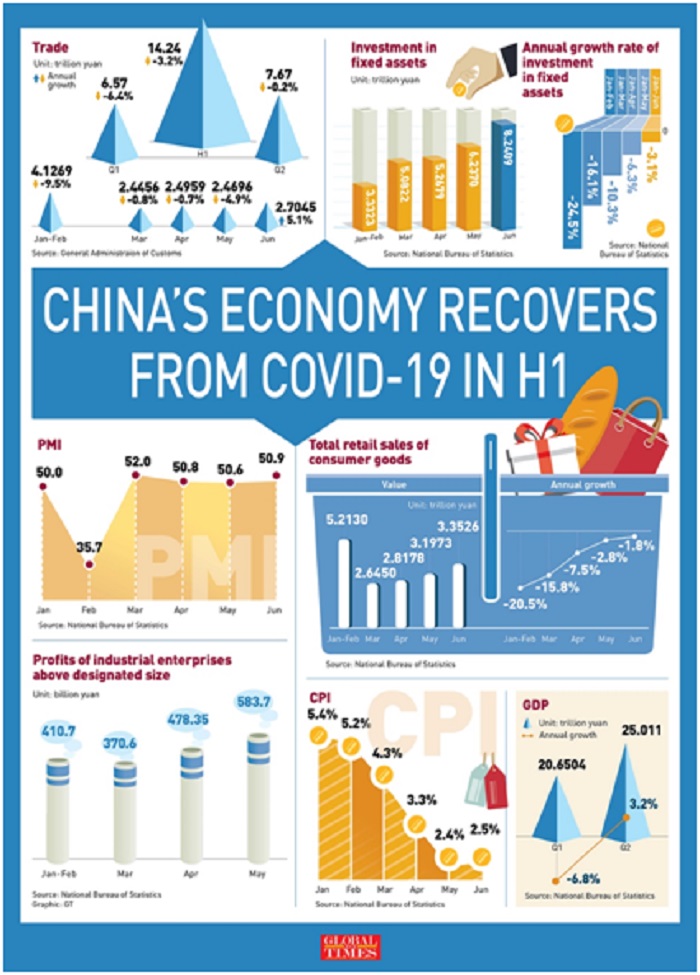



China’s GDP contracted 1.6 percent for the first time in the first half of a year in nearly three decades, battered by COVID-19 headwinds. But in the second quarter, the economy grew 3.2 percent, reversing from a 6.8-percent contraction in the first quarter, a sign of the resilience deeply rooted in China’s economy amid a global freefall when the coronavirus pandemic has plunged most major economies into a near standstill.
Retail sales plummeted 11.4 percent year-on-year to 17.22 trillion yuan ($2.46 trillion) in the first half. Industrial added-value contracted 1.3 percent, while fixed-asset investment slumped 3.1 percent to 28.16 trillion yuan, according to data released by the National Bureau of Statistics (NBS) on Thursday.
The unemployment rate was 5.7 percent in June, a 0.2 percentage point decrease compared with May, the data showed.
“The second-quarter performance was better than expected, as production on the supply side picked up and investment caught up. The economy in the latter half of the second quarter moved from post-virus recovery to periodic climbing up to a certain extent,” Tian Yun, vice director of the Beijing Economic Operation Association, told the Global Times.
In June alone, retail sales sank 1.8 percent year-on-year, narrowing from a 2.8 percent contraction in May. Industrial value-added rose 4.8 percent, marking the third consecutive month of renewed growth.
Despite what might be the low single-digit growth in the second quarter, China could still achieve best-in-class results among the world’s major economies and lead the global recovery in the wake of the pandemic, analysts said.
Given the current trajectory, China is expected to surpass the US in terms of GDP output by 2030, although on a per capita level the catch-up will take much longer, analysts said.
In late June, the IMF lowered its forecast for the global economy this year to a decline of 4.9 percent. The US economy is expected to shrink 8 percent in 2020, while China’s GDP is projected to grow 1 percent.
Tian noted that China’s swift economic rebound in the second quarter also shows the way for the rest of the world, including the US and India, where the coronavirus resurgence is wiping out progress. The lesson is to pay a certain price to control the virus, then shore up the economy with stimulus measures.
In the first quarter, China’s GDP shrank by 6.8 percent for the first time in decades as economic activity ground to a halt amid stringent anti-epidemic measures.
However, economists noted that China’s GDP is unlikely to achieve a V-shaped recovery due to sluggish domestic and foreign demand.
“Consumption – the chief engine of the Chinese economy – is climbing, but at a slower-than-expected rate. We don’t see momentum in releasing pent-up demand to date,” Tian said.
He noted that the coronavirus outbreak had caused about 1,000 yuan in losses for every Chinese person on average so far. That money should have gone into consumption, and it’s therefore hard to recoup.
Looking into the second half, the economy is expected to continue its recovery and outperform the second quarter, due to improvements on both the supply and demand sides, Liu Xuezhi, a macroeconomics expert at the Bank of Communications, told the Global Times.
Tian estimated that China’s economy could achieve 3-4 percent growth in the second half and 1-2 percent growth for the whole year, as the second half accounts for more than half of China’s normal annual economic output.
Liu warned that a declining global economy and the potential worsening of the COVID-19 pandemic may continue to weigh on China’s export growth and disrupt global supply chains, despite the better-than-expected export figures recorded in the first half.
He said that macroeconomic policies would lean toward economic stabilization and employment.
In the first half, China’s foreign trade declined 3.2 percent year-on-year to 14.24 trillion yuan ($2.03 trillion). That decline was 1.7 percentage points less than the yearly decrease of the first five months, customs data showed.
Source: Global Times


The Humanitarian Service Diamond Awards has.
A Chinese Company, Inner Galaxy Steel.


The Programme Coordinator, Regulatory, Compliance and.


A Non-Governmental Organization (NGO), Committee for.
The Trustfund Pensions Limited has chided.


The House of Representatives Committee on.
The China General Chamber of Commerce.


Senator Chuka Utazi who represented Enugu.


An Abuja based Legal Practitioner, Ugochukwu.


The African business community in Yiwu,.
Leave a Comment